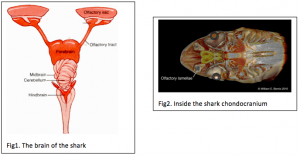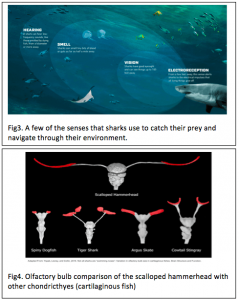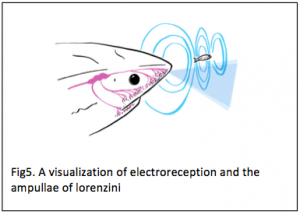According some experts estimations, sharks have been around planet Earth for somewhere between 425 and 450 million years making them just as old or even older than trees themselves! As such, sharks have had time to evolve numerous methods of sensing their environment, making them expert hunters. In order to understand shark senses, one must first understand where the perception of these different sensations occur in the shark brain.
The shark brain is a Y shaped organ located in the chondrocranium of the shark. The shark brain can be split up between the forebrain, midbrain and hindbrain, each of which will specialize in a different sense. The forebrains specializes in olfactory, midbrain in visual, and the hindbrain specializes in hearing, touch, and electroreception.
 Depending on the species sharks can smell up to 1km or more away, hear about 100m away, see about 10m away depending on water clarity. Depending on the sharks environment/habitat there will be corresponding enlargements in the brain. If the shark lives in deeper water where not much light exist or live mostly in the open ocean where food availability tends to be low, they might have enlargements in their forebrains because they have to rely on olfaction to find their food. With over 400 different species of sharks, not all sharks are necessarily the “swimming noses” that we think they are. With such diversity, sharks will specialize in different senses based on the environment of which they live. Even with one sensory specialization, it is the combination of all the shark’s senses that make them such great predator.
Depending on the species sharks can smell up to 1km or more away, hear about 100m away, see about 10m away depending on water clarity. Depending on the sharks environment/habitat there will be corresponding enlargements in the brain. If the shark lives in deeper water where not much light exist or live mostly in the open ocean where food availability tends to be low, they might have enlargements in their forebrains because they have to rely on olfaction to find their food. With over 400 different species of sharks, not all sharks are necessarily the “swimming noses” that we think they are. With such diversity, sharks will specialize in different senses based on the environment of which they live. Even with one sensory specialization, it is the combination of all the shark’s senses that make them such great predator.

As sharks draw in closer to their prey they use electroreception. Imagine the brain as a biological computer, sending electrical impulses down a highway of motor neurons in order to move the muscles of the body. Sharks are able to detect those electrical impulses from up to 1 meter away. Some sharks, such as the scalloped hammerhead, can sense as low as half a billionth of a volt of electricity. They use special gel filled pores called the Ampullae of Lorenzini in order to sense these weak electrical impulses.
Sharks will continue to dazzle and amaze us with their sensory capabilities. New research indicates that sharks can even use electroreception to navigate the earth by sensing the magnetic poles. Such extraordinary evolutionary advantages are what will continue to make sharks a dominant predator for a very long time.
COVER PHOTO CREDIT:
Brian Skerry, www.brianskerry.com from https://ocean.si.edu/ocean-life/sharks-rays/hammerhead-shark-sunset
References
Fig5
https://www.sharkbanz.com/pages/how-it-works
Fig4
http://blogs.uwa.edu.au/3dbrainprinting/files/2016/03/March_OB-x9twud.jpg
Fig.3
https://sharkopedia.discovery.com/wp-content/uploads/2015/07/sharkopedia-hierarchy-of-senses-550×350.jpg
Fig2
William E. Bemis 2016
Fig1
Hammerhead video
https://www.smithsonianmag.com/videos/category/science/hammerhead-vs-stingray/


